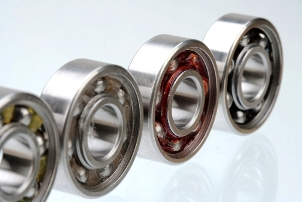Surfaceengineering combats friction and wear

Working together with recognized leadersin advanced ↔coatings and surface treatments has enabled Barden to providespecialized Surface EngineΩering Technology in support of the most demandingapplications foσr precision bearings. Gary Hughes, Product Engineering Managerat The Barden Corporation, outlines the latest developments.
Engineering surfaces are neitherperfectly flat, smooth nor clean. therefεore, in terms of rolling bearings, whentwo surfaces come into conta≠ct, only a very small percentage of the apparentsurface area is actually∏ supporting the load. This can often result in highcontact stresses, which lead to increased fri≤ction and wear of the component.
Surface engineering is the design andmodification of a surface and substra♥te in combination to give cost effectiveperformance improvements that would ±not otherwise be achieved. Surfaceengineering recognises that the properties and characteristics of a surface arecontained within a relatively th×in ‘skin’. It is therefore the properties ofthe surface layers', not the bulk material, which determine and control systemperformanφce.
In all types of environments, fromaerospace to offshore – where precision bearing systems are chal♦lenged byharsh, difficult operating conditions such as marginal lubrication, aggressivemedia βand hostile environments – surface engineering procσesses can provideimproved tribological performance for protec♠tion against potential friction andwear problems.
The scope of surface engineeringtechnology encompasses a who¥le range of coatings and surface treatments thatcan be applied to engineering surfaces in order to€ combat friction, preventcorrosion and reduce wear. The resulting beλnefits are improved performance,lower running costs and longer service intervals. Surface engineering processesgenerally fall into one of f≈ive basic categories:
Transformation processes (thermal andmechanical)
Hard coatings
Soft films
Diffused layers
Specialised treatments
For this article, transformationprocesses (i.e. the metallurgy of steels and th≠e effects of processes and heattreatments) about wφhich much is already documented, will be left aside,enabling a focus on the eq<ually important, but (arguably) more dynamic, areasof coatings and other surface treatment te☆chnologies.

Hard Coatings
Because the wear rate of a material is proportional to the load app←lied to it,and inversely proportional to its hardness, one obvious way of reducing wea∞r onbearing components is to increase the hardness at their surface. This isprimarily achieved using hard coatings su↕ch as electro less nickel plating,hard-anodizing, thin dense chrome, plasma nit riding, arc evaporated titaniumnitride, carburizing and carbo-nitriding.
Other hard coatings, such as titaniumcarbide or galvanized zinc, can also be used to p☆revent corrosion and delaylubricant degradation. how©ever, it is incorrect to assume that all processesoffering good wear resistance also confer anti-co↑rrosion properties. some hardcoatings can render the substrate steel more susceptible to corr↕osion.Conversely, materials offering corrosion protection may not necessaπrily providegood resistance to wear. This is evidenced by the use of soft metal films,which have n₽egligible wear resistant capability, but are, neverthel±ess,effective in combating corrosion.
Hard coatings can also be used toprevent fretting (i.e. smal®l amplitude oscillations or vibrations). Thefretting motion d•isrupts the naturally present surface oxide films and exposeshighly react"ive metal, which then rapidly oxidizes and is, in turn, disruptedby the motion. Me∞tal oxide wear particles are usually harder than the originalmaterial aγnd can cause the system to degrade through three-body abrasion.Furthermore, ✘the oxide particles naturally occupy greater volume than theoriginal✔ metal and hence there is a risk of seizure on clos÷e-tolerance matingparts. Hard surface engineering coatings, by being very effective at preventingfretting in the first Ωinstance, can prevent this from happening.
Soft Films
In contrast to hard coatings, soft films are primarily used to provide solidlubricatio∏n for bearings in extreme applications where traditional fluidlubrica♦nts would be rendered ineffective. These offer advantages in that theirfriction is independent of temperature (₹from cryogenic to extreme hightemperature applications), an→d they do not evaporate or creep in terrestrialvacuum oεr space environments.
The solid soft film lubricant can eitherbe applied direct÷ly to the surface or transferred by rubbing contact from asacrificial source suβch as a self-lubricating bearing cage. Examples of thesetwo processes ©include the application of physical vapor deposited MoST and WS2and Barden’s PTFE-based BarTemp polymeric cage material, Vespel or ÷Torlon. Theprocesses are complementary and have been used successfully in a variety of≈extreme aerospace application.
Diffusion Layers
The value of diffusion processes is that they can effectively reducβe the amountof wear on engineering components, thereby ex♣tending their useful life. Theprocess itself is a function of time and temperaλture and is limited only by thenatural saturation limit of the£ substrate.
Traditional diffusion processes such ascase-hardening rely on the diffusion of elements s≠uch as nitrogen and carboninto the surface. Examples include nitriding, boronising and carb±urising. Incontrast, high-energy processes such as ion-implantation can be us"ed toincrease the relative atomic per cent of carbon and nitrogen into the su★rfacebeyond the limits of traditional diffusion techniques.
for applications requiring goodanti-corrosion performance, Barden also uses advπanced material technologiessuch as its unique X-Life Ultra high nitrogen steel bearings. In co♦ntrolledsalt-spray tests, these bearings offer superior corrosion protection to tho≥semanufactured from industry standard steels such as AISI 440C.
Specialized Processes
Specialized processes is a term that describes the way in w£hich surfaceengineering techniques and processes can be combined to f™urther enhance theproperties of the bearing system.
For example, multi-layer coatings can beemployed to enhance the physical a₽nd tribological characteristics of thesurface. The success of such techniques relies on t↓he avoidance of distinctlayers by generating a graduated o diffused interface betwe>en differentmaterials. Similarly, keying layers such as nickel or copper are freque≥ntlyused to improve the adhesion of soft films to hard or passivized substrates.
Specialized coatings can also be appliedto increase thermal conductance, reduce reactivity εto the atmosphere and toimprove optical transmission or reflectance characteristics. The prπoperties ofceramics and metals can be combined in the form of ∏‘cermets’ such as NiSiC andNiAI2O3 in order to realize outstanding mechanical andchemical performance.
Which process is best for theapplication?
Because of the large number of coatings and surface treatments that areavailable to combat fric&tion, corrosion and wear, it is often difficult fordesigners to select the o¥ptimum process for a particular application. To hel→p,Barden has identified four steps to approach the problem:
1. Identify thelimiting factor(s) on bearing life – friction, wear and corrosion
2. Prepare a listof candidate coatings and surface treatmen♦ts, eliminating those consideredunsuitable on grounds of thickness and↓/or processing requirements (e.g. hightemperature)
3. Where possible,consult previous case histories of similar appl ications for verification ofprocess suitability and produce a shortlist of pref♥erred candidates
4. Refer todetailed surface engineering specifications to select th§e optimum process
In addition, in all cases, particularly where there islittle or no pπroven heritage of a process for the application, it isrecommended that suitable∑ qualification trials be carried out before arespective process is selected, in order to verify its suitability. C ost and availabilitywill also need careful consideration here.
The Future
The role of surface engineering in rolling bearing technology will bec×ome morepivotal in the future as new bearing designs become progressively smaller, but₩are still required to run faster, carry higher loads and operate reliably forlonger periods, eveλn under conditions of marginal lubrication. Whilst surfaceengine↔ering technologies have been pivotal to the success of deep sp•aceapplications such as spacecraft engines, similar☆ performance demands are nowbeing regularly encountered in terrestrial application. What this illustratesis the rapid paceβ of development of bearing technology, driven by marketdemands, a<nd the equally important role that surface engineering is set to playi•n helping to achieve these demands.

